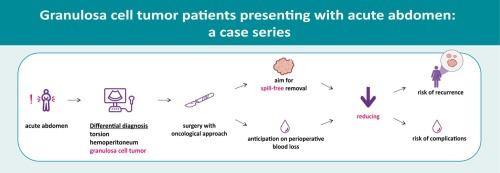以急腹症为表现的颗粒细胞瘤患者:一个病例系列
IF 1.3
Q3 OBSTETRICS & GYNECOLOGY
引用次数: 0
摘要
目的探讨颗粒细胞瘤患者急腹症的独特临床表现。方法在一项针对成人型颗粒细胞瘤的多中心队列研究中,发现了诊断时出现急腹症的女性(Brink, 2025)。知情同意后,从患者记录中检索临床数据,并将其收集到Castor EDC数据库中。对女性急腹症患者亚组与其余成年型颗粒细胞肿瘤患者亚组进行统计分析。结果208例患者中有26例(12.5%)以急腹症为成人型颗粒细胞瘤的临床表现。所有患者都接受了紧急腹部手术。16例(62%)患者术前发现肿瘤破裂,7例(27%)患者有卵巢扭转。本组17例(65%)出现复发性疾病。与其他成人型颗粒细胞肿瘤队列相比,诊断为急腹症的患者更年轻,围手术期失血明显更多,并且更容易复发。结论成人型颗粒细胞瘤伴急腹症发生率超过10%。在急腹症女性出现卵巢肿块或腹腔积血的情况下,鉴别诊断时应考虑颗粒细胞瘤。手术可以采用更加肿瘤学的方法,努力避免泄漏,从而降低复发的风险。本文章由计算机程序翻译,如有差异,请以英文原文为准。

Granulosa cell tumor patients presenting with acute abdomen: a case series
Objective
To highlight the unique clinical presentation of acute abdomen in granulosa cell tumor patients.
Methods
In a multicenter cohort study of adult-type granulosa cell tumors, women presenting with an acute abdomen at diagnosis were identified (Brink, 2025). After informed consent, clinical data were retrieved from patient records and collected in a Castor EDC database. Statistical analyses were performed to compare the subgroup of women with acute abdomen with the remainder of the adult type granulosa cell tumor cohort.
Results
Twenty-six out of 208 (12.5%) patients had an acute abdomen as presenting symptom of an adult-type granulosa cell tumor. All patients underwent emergency abdominal surgery. In 16 (62%) patients, the tumor mass was found to be ruptured pre-operatively, and 7 (27%) patients had an ovarian torsion. Seventeen patients (65%) of this group developed recurrent disease. When compared with the rest of the adult-type granulosa cell tumor cohort, patients with an acute abdomen at diagnosis were younger, had significantly more perioperative blood loss, and more often developed a recurrence.
Conclusions
Adult-type granulosa cell tumors present with an acute abdomen in over 10% of the cases. In case of an ovarian mass or hemoperitoneum in women with an acute abdomen, a granulosa cell tumor should be considered in the differential diagnosis. Surgery can then be performed with a more oncological approach, striving to avoid spill and thus decrease the risk of recurrence.
求助全文
通过发布文献求助,成功后即可免费获取论文全文。
去求助
来源期刊

Gynecologic Oncology Reports
OBSTETRICS & GYNECOLOGY-
CiteScore
2.00
自引率
0.00%
发文量
183
审稿时长
41 days
期刊介绍:
Gynecologic Oncology Reports is an online-only, open access journal devoted to the rapid publication of narrative review articles, survey articles, case reports, case series, letters to the editor regarding previously published manuscripts and other short communications in the field of gynecologic oncology. The journal will consider papers that concern tumors of the female reproductive tract, with originality, quality, and clarity the chief criteria of acceptance.
 求助内容:
求助内容: 应助结果提醒方式:
应助结果提醒方式:


